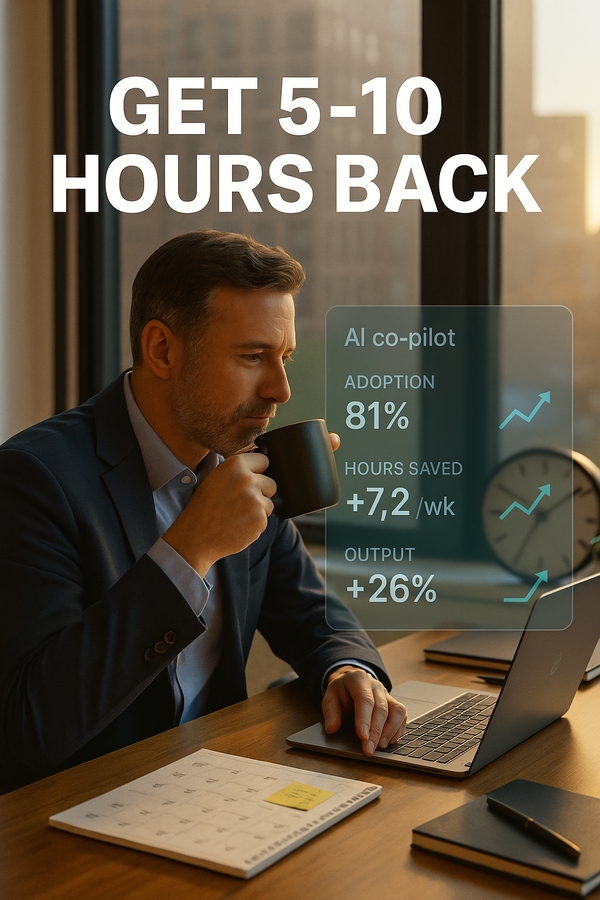The world of business is in the middle of a high-stakes, high-tech transformation. The engine of change? Artificial Intelligence "agents." This isn't just about another chatbot or a clever demo. We're talking about a fundamental rewiring of how work gets done, and the smartest companies are moving now.
This week, AI agents crossed a critical threshold—from cool science projects to practical, shippable tools that can solve real business problems. New toolkits are slashing development time, AIs can now use software without special access, and shareable plugins are turning individual tools into team-wide superpowers.
So, how do you harness this power? Let's deconstruct the new landscape of AI agents and build a blueprint for putting them to work in your organization.
Series: AI in Practice
Who it’s for: Business Owners, Founders, & Team Leads
Outcome: Understand how to leverage the latest AI agent capabilities to improve efficiency and create value in your business.
Start here: To implement a winning AI cost-reduction strategy in your own organization → Explore AI for Cost Reduction
In This Article (Table of Contents)
- The Secret Weapon: Ship-Ready "Agent Kits"
- No API? No Problem: Agents That Click and Type
- The Team Supercharger: Shareable AI Plugins
- The Bigger Picture: Speed, Cost, and Security
- Your 30-Day Game Plan to AI Adoption
- The Final Verdict: Ops Moat > Model Choice
- Frequently Asked Questions
- Key Terms You Need to Know
- Related Playbooks
The Secret Weapon: Ship-Ready "Agent Kits"
The biggest barrier to using AI agents used to be the mountain of custom code and "glue work" required to get a simple idea off the ground. That barrier just crumbled.
The Breakthrough
Production-ready "agent kits" are here. Think of them like a professional LEGO set for building AI workers. They bundle the core components—orchestration, connectors to other apps, basic user interfaces, and evaluation tools—into one package. This lets you go from idea to a usable, internal tool in hours, not weeks.
The Business Impact
This is a game-changer for internal innovation.
- Slash Development Time: Cut the tedious setup and integration work that bogs down projects.
- Standardize Measurement: Built-in logging and evaluation mean you can actually compare the performance of different agents and prove their value with data.
- Lower the Bar for Entry: You no longer need a dedicated AI team to build a proof-of-concept. A smart engineer can get a valuable agent up and running in an afternoon.
Quick Wins (What to Build This Week)
- GitHub Issue Triage Agent: Automatically classify bug reports, identify duplicates, and summarize issues for your engineering team. Key Metric: Time-to-Resolution (TTR) and duplicate catch rate.
- Ops Inbox Sorter: Route incoming emails for billing, support, or sales to the right person or department automatically. Key Metric: Mis-routing percentage.
- SOP Answer Bot: Field questions from your team by finding answers in your internal documentation and providing citations. Key Metric: Reduction in repetitive questions to managers.
The bottom line: These kits let you prove value fast. Founders should target a time-to-first-use of less than 1 day and aim to reduce human handoff rates by 25–40% within the first month.
No API? No Problem: Agents That Click and Type
One of the most exciting developments is the rise of "computer use" agents. These AIs don't need a special connection (API) to use a piece of software. Instead, they operate it just like a person would: by looking at the screen, clicking buttons, and typing in forms.
Where This Wins Big
This unlocks automation for a huge category of frustrating, manual tasks.
- Legacy Systems & Vendor Portals: Automate work in old internal software or third-party websites that will never have a modern API.
- Multi-Step Approvals: Navigate complex claims and approval workflows that require logging into multiple systems.
- Repetitive Back-Office Work: Handle any process that mixes copy-pasting with light human judgment.
The Trust Imperative: Essential Guardrails
Letting an AI click around in your apps requires a new level of operational maturity.
- Audit Trails: Use session screenshots and detailed action logs to maintain a clear record of everything the agent does.
- UI Monitoring: Set up tests to detect when a website's layout changes, which could confuse the agent.
- Safety Switches: Implement per-task timeouts and a "safe stop" hotkey for human oversight.
The Team Supercharger: Shareable AI Plugins
AI is moving from a solo tool to a team sport. The latest coding assistants allow you to package specialized sub-agents and automated workflows into shareable "plugins" that can be versioned and distributed to your entire team.
The Strategy: Augment Your Best People
Instead of just giving everyone a generic AI assistant, you can now build and share specialized tools that amplify your team's specific workflows.
- The Proof: A "Release Engineer" sub-agent can run tests and post code changes automatically. A "Doc Stitcher" can convert approved code into user-facing documentation. A "Security Sieve" can flag risky code before it gets merged.
- The Bet: By creating a library of custom, shareable AI tools, you create a powerful flywheel. Your team gets more productive, and their feedback helps you make the tools even better. The key metric to watch is PR lead time, with a target reduction of 20-30% in 30 days.
The Bigger Picture: Speed, Cost, and Security
This agent-driven world is built on two foundational pillars that are also shifting: the raw infrastructure that powers AI and the security models that protect it.
1. Infra Signal: Faster, Cheaper, Better
The underlying capacity to run AI models continues to ramp up. This isn't just a technical detail; it's a core business driver.
- What it means for you: Expect a faster release tempo for new models and falling unit costs.
- Your move: This makes it more economical to fine-tune smaller, specialized models for high-value tasks. Your strategy should be built on swappability—standardize your evaluations so you can easily switch to a better, cheaper model when it drops.
2. Security First: Hardening and Safety
As agents become more powerful, security moves from a checklist item to a day-one priority.
- The Shift: Agents are moving from suggesting code fixes to implementing them. At the same time, we're learning that "data poisoning" (a few bad examples) can skew an entire fine-tuned model.
- Your move: Gate all AI-generated code through your existing CI/CD pipeline with human approval. Tag all training data with its origin. Stand up monitors to detect if your model's behavior starts to drift.
Your 30-Day Game Plan to AI Adoption
Thinking big starts with winning small. Here’s a practical plan to get your first agent into production and prove its value.
Week 1 — Prove Value
- Pick one process: Choose a high-pain, low-risk task (like GitHub triage or a simple portal automation).
- Define 2 KPIs: What does success look like? (e.g., TTR, handoff rate).
- Ship a POC: Get a "version 0.1" in front of 3–5 friendly internal users.
Week 2 — Instrument
- Add Guardrails: Implement run-logging, automatic retries, and basic evaluations.
- Wire Alerts: Set up notifications for failures and SLA breaches.
- Draft Governance: Write a one-page doc: what it can/can't do, who's the owner.
Week 3 — Expand
- Add a second process: Show that the framework is reusable.
- Add feedback loops: Add "this helped" / "this was wrong" buttons and a queue for fixes.
- Publish docs: Create a simple "how we use it" guide for the wider team.
Week 4 — Decide
- Keep, Kill, or Scale: Look at your KPIs. Is it working?
- If Keep: Set a formal budget, assign a permanent owner, and define quarterly OKRs for the agent.
The Final Verdict: Ops Moat > Model Choice
Here’s a contrarian take: your edge this quarter isn’t the model; it’s ops maturity.
Everyone is chasing the newest, shiniest large language model. But the real winners will be the teams that get good at the "boring" stuff: standardizing logging, building robust evaluations, enabling safe UI control, and managing governance.
A team that masters operations will compound its learnings and deploy new agents faster and more safely. A well-managed B+ model will beat a chaotic A+ model every single time.
Frequently Asked Questions
What is an "AI agent kit"?
An AI agent kit is a pre-packaged set of software tools that bundles the core components needed to build, deploy, and manage an AI agent. This includes orchestration (how the agent thinks and plans), connectors (to talk to other apps), and evaluation hooks (to check its work), dramatically speeding up development.
Why is a "computer use" agent a big deal?
Most software automation relies on APIs (Application Programming Interfaces), which are special "doors" for computers to talk to each other. A "computer use" agent doesn't need an API. It sees the screen and uses the mouse and keyboard just like a human. This unlocks automation for thousands of older systems and third-party websites that have no other way to be automated.
What is an "Ops Moat" in AI?
An "Ops Moat" refers to the competitive advantage a company builds by being excellent at operations (Ops). In AI, this means having mature, standardized systems for logging, evaluating, deploying, and securing AI agents. This operational excellence allows a company to innovate faster and more reliably than competitors, even if they are using the same AI models.
Key Terms You Need to Know
- AI Agent Kit: A starter pack of developer tools that bundles orchestration, connectors, and evals to help build and ship AI agents quickly.
- Computer Use Agent: An AI that can operate software by directly viewing the screen and controlling the mouse and keyboard, removing the need for an API.
- Ops Moat: A competitive advantage built not from a specific technology (like a model) but from superior operational processes for managing that technology (like logging, evals, and governance).
Related Playbooks
Explore next:
Customer Retention AI · AI Customer Service



